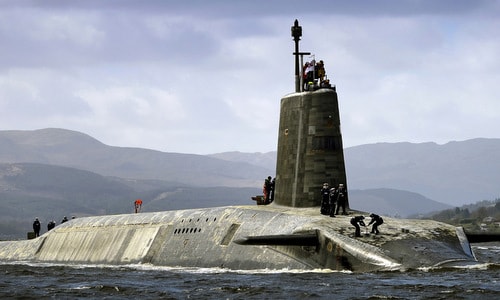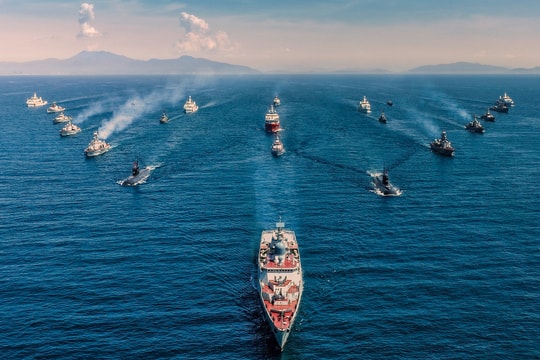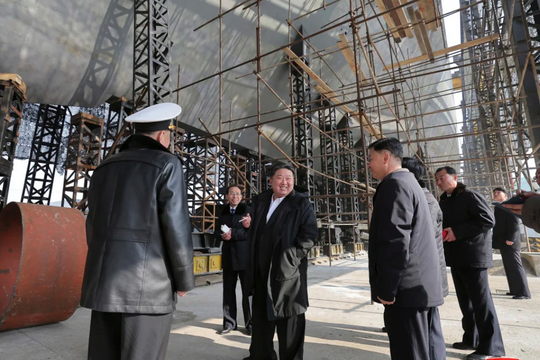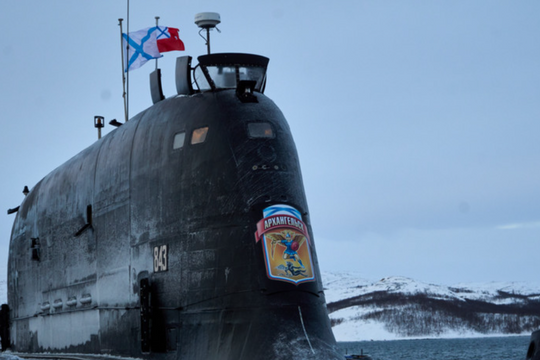Britain's only nuclear deterrent submarine fleet
Four Vanguard-class submarines carrying ballistic missiles with a power equivalent to 120 million tons of TNT are Britain's only nuclear deterrent.
Vanguard-class submarine returns to port after patrol
The Royal Navy maintains a fleet of four Vanguard-class strategic submarines equipped with powerful nuclear ballistic missiles capable of wiping out the world's largest countries. This has been the only nuclear deterrent force in the British military for the past 50 years, according to National Interest.
In the early 1960s, the British nuclear deterrent was built on the basis of a trio of strategic bombers called "V-Force", including the Avro Vulcan, Handley Page Victor and Vickers Valiant. They were equipped with the US-made GAM-87 Skybolt air-launched ballistic missile, which could penetrate the Soviet defense system thanks to its speed of up to 15,300 km/h. However, the Skybolt missile had so many technical errors that the US government canceled the project in 1962.
The US suspension of the Skybolt program caused the UK to lose its nuclear deterrent, forcing the two countries to find a solution together. Washington proposed using the UGM-27 Polaris submarine-launched ballistic missile (SLBM) to replace Skybolt. To implement this solution, the UK had to build strategic submarines capable of carrying ballistic missiles.
The British Ministry of Defense estimated that the country needed at least five Polaris-class strategic submarines to maintain a credible nuclear deterrent. London later reduced that number to four. The first solution was the Resolution-class submarine, based on the US Navy's Lafeyette-class ballistic missile submarine. Each submarine had two missile launchers with a total of 16 missiles behind the bridge.
The submarines were all built in Britain, but used American missiles, launchers, and fire control systems. Each was equipped with 16 Polaris A-3 missiles with a range of 4,025 km, equipped with a British-made nuclear warhead. The upgraded Polaris A-3TK version was later equipped with six Chevaline independent warheads, each with a destructive power equivalent to 150,000 tons of TNT or 10 Hiroshima-class atomic bombs.
HMS Resolution was the lead ship of the Resolution class, commissioned in 1967 andThe first successful test launch of the Polaris missile took place in January 1968 off the coast of Florida, USA.. Three further submarines were commissioned in 1968-1969.
 |
The submarine HMS Vigilant before setting sail. Photo: SeaForce. |
By the early 1980s, the Resolution class was becoming obsolete and needed to be replaced. The UK decided to build four new Vanguard-class ships, each armed with the American Trident nuclear missile. The first, HMS Vanguard, entered service in 1993, followed by HMS Victorious in 1995, HMS Vigilant in 1996 and HMS Vengeance in 1999. The Vanguard successfully test-fired a Trident II ballistic missile for the first time in 1994, before entering combat patrol a year later.
With a displacement of 15,000 tons, the Vanguard class is twice the size of the previous Resolution class. The submarine was designed to have 16 SLBM launch tubes, but the British Ministry of Defense decided to equip each submarine with only eight Trident II D-5 missiles with a range of 7,400 km.
Each Trident II D-5 missile can carry up to eight warheads with a combined explosive yield equivalent to 3.8 million tons of TNT. This allows a Vanguard-class submarine to carry weapons equivalent to 30 million tons of TNT, or 2,000 Hiroshima bombs. In total, the fleet of four Vanguards is equipped with warheads equivalent to 120 million tons of TNT, enough to wipe out any country in the world.
Each submarine classVanguardThey are manned by two rotating crews to maintain combat readiness. Under the Continuous At Sea Deterrence (CASD) programme, the UK always has at least one Vanguard-class submarine on patrol at any given time, one is off patrol and preparing for rest, another is ready to go out to sea, while a fourth is undergoing maintenance. For the past 48 years, a British submarine has been at sea every day.
Vanguard-class submarine test-fires Trident ballistic missile.
In September 2016, the Royal Navy began construction on the Successor submarine, the first of the new generation Dreadnought class with a displacement of 17,200 tons. Each submarine will be equipped with 12 launch tubes, reusing Trident D-5 missiles from the Vanguard class.
The Dreadnought class is expected to enter service in the 2030s and serve until the 2060s. The British Ministry of Defense estimates it will cost $39 billion to operate the fleet for 35 years, with about $12 billion in contingency costs.
By maintaining a fleet of four SLBM-carrying submarines, Britain ensures that it has at least 64 nuclear warheads at sea, ready to launch an attack in minutes. This is enough strategic weapons to deter and prevent any opponent from planning a preemptive strike on London, military expert Kyle Mizokami commented.
According to VNE
| RELATED NEWS |
|---|


.png)

.png)


